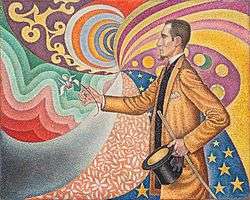Félix Fénéon

Félix Fénéon (22 June 1861, Turin, Italy – 29 February 1944, Châtenay-Malabry) was a Parisian anarchist and art critic during the late 19th century. He coined the term "Neo-Impressionism" in 1886 to identify a group of artists led by Georges Seurat, and ardently promoted them.
The Fénéon Prize was established in 1949 by his wife based on proceeds from the sale of his art collection.
Life
Felix Fénéon was a prominent literary stylist, art critic, and anarchist born in Turin, Italy in 1861.[1] He was later raised in Burgundy, presumably because his father was a travelling salesman. After placing first in the competitive exams for jobs, Fénéon moved to Paris to work for the War Office where he achieved the rank of chief clerk.[1] During his time in the war office he edited many works, including those of Rimbaud and Lautréamont, as well as helped to advance the fledgling pointillist movement under Georges Seurat.[2] He was also a regular at Mallarmé’s salons on Tuesday evenings as well as active in anarchist circles.[1]

Fénéon, ironically, worked 13 years at the War Office while remaining heavily active in supporting anarchist circles and movements.[3] In March 1892 French police talked about Fénéon as an 'active Anarchist', and they had him shadowed.[2] In 1894 Fénéon was arrested on suspicion of conspiracy because of an anarchist bombing of the Foyot restaurant, a popular haunt of politicians.[2] He was also suspected of connection with the assassination of the French President, Sadi Carnot, by an Italian anarchist[2] He and twenty-nine others were arrested under charges of conspiracy in what became known as the "Trial of Thirty". Fénéon was acquitted with many of the original thirty.[1] However, the trial was a high point in publicity for Fénéon, normally behind the scenes, as he championed his wit to the amusement of the jury. Of the courtroom scene, Julian Barnes writes, "When the presiding judge put it to him that he had been spotted talking to a known anarchist behind a gas lamp, he replied coolly: Can you tell me, Monsieur le Président, which side of a gas lamp is its behind?"[3]
After the trial, Fénéon became even more elusive. In 1890, the Neo-Impressionist Paul Signac asked to produce a portrait of the lauded critic. Fénéon refused several times before agreeing, on the condition that Signac produced a full face effigy. Signac naturally refused, painting instead a famous profile of Fénéon with his characteristic goatee, a picture that largely became a symbol of the movement, spawning many variations. Fénéon, though displeased, hung the picture on his wall until Signac’s death 45 years later.[3]
Aside from Novels in Three Lines that first appeared as clippings in the Parisian Le Matins in 1906 and later as a collection, only because his mistress Camille Pateel had collected them in an album, Fénéon published only a 43-page monograph in Les Impressionists (1886). When asked to produce Les Nouvelles en Trois Lignes as a collection, Fénéon famously replied with an angry "I aspire only to silence".[3] As Luc Sante points out, Fénéon, one might say, is invisibly famous, having affected so much without being recognizable to many.

Fénéon’s lawyer offered him a post at La Revue Blanche after the trial and his subsequent expulsion from the War Office, however, he worked for that magazine until 1903. In that time, he went on to promote the works of Seurat and Signac through the magazine. He organized the first retrospective of Seurat’s work in 1900.[2] Seurat is known for a number of works, most significantly La Grande Jatte. Hajo Düchting, the author of Seurat, The Master of Pointillism notes that "Actually he (Fénéon) was the only critic who proved capable of articulating an appreciation of Seurat's picture, and the new method of painting it exemplified, in words notable for their objective tone".[4]
After La Revue Blanche failed, Fénéon went to work for the liberal paper Le Matin, where he anonymously composed daily news "filler", what the French call "faits-divers" or "sundry events", of three lines each. His authorship was not revealed until the 1940s.[2] In these he captured the complex subtleties of French daily life. The following examples highlight the wit of such a critic of the mundane:
- A criminal virago, Mlle Tulle, was sentenced by the Rouen court to 10 years hard labor, while her lover got five.
- In a café on Rue Fontaine, Vautour, Lenoir, and Atanis exchanged a few bullets regarding their wives, who were not present.
- "If my candidate loses, I will kill myself," M. Bellavoine, of Fresquienne, Seine-Inferieure, had declared. He killed himself.
- Women suckling their infants argued the workers' cause to the director of the streetcar lines in Toulon. He was unmoved.[5]
After his post at Le Matin , Fénéon directed the Galerie Bernheim-Jeune and became increasingly involved with Neo-Impressionism, especially the art of Georges Seurat.[2] He was the director of the gallery from 1906 to 1925. Before the his retirement from the gallery, he is reported to have told a friend that he was "ready for idleness", and then he abruptly quit at the age of 63.[2]
Works
- Les Impressionnistes en 1886
- Œuvres; preface by Jean Paulhan, Paris, Gallimard, 1948
- Œuvres plus que complètes, 1970
- Nouvelles en trois lignes, translated and published as Novels in Three Lines with introduction by Luc Sante, 2007 ISBN 978-1-59017-230-8
- Correspondance de Fanny & Félix Fénéon avec Maximilien Luce, 2001
- Petit supplément aux œuvres plus que complètes, 2 volumes
- Le Procès des Trente, 2004
- Correspondance de Stéphane Mallarmé et Félix Fénéon. Maurice Imbert, editor; 2007
References
External links
| Wikimedia Commons has media related to Félix Fénéon. |
- Olga's Gallery Newsletter: Félix Fénéon and Pointillism
- Signac, 1863-1935, a fully digitized exhibition catalog from The Metropolitan Museum of Art Libraries, which contains material on Félix Fénéon (see index)